Audio Archaeology: The Birth of Disco Uncovered--"I'll Be Around" by The Spinners, Written by Thom Bell and Phil Hurtt
The story of the 1 song that appears to have lit the fuse for the Disco boom. Without it, Studio 54 would've just been a dry cleaner's, and you'd have nowhere to wear your platforms...but the library.
The Birth of Disco
The Spinners and their “I’ll Be Around,” produced by the late Thom Bell on Atlantic Records: This otherwise innocuous (but undeniably smooth and creamy ear-pudding with a beat) early-’70s hit just might have laid the musical foundation for the rest of the ‘70s, especially anything under the dance/disco/R&B banners.
I had always considered the Hues Corporation’s (pictured above) “Rock the Boat” (recorded in 1973, but not released as a single until the following year), the “first disco record.” I was a DJ at a tiny club across the street from the University of Houston in ‘74, and recall dancers doing a synchronized step that resembled a square (4-Square?); they did that to “Rock the Boat” and in early ‘75, Earth, Wind & Fire’s “Shining Star.”
More to the point, though, it turns out that “I’ll Be Around,” recorded at Philly’s Sigma Sound, is the solid cornerstone and foundation of TSOP (The Sound of Philadelphia) and MFSB (Mother Father Sister Brother, Sigma Sound’s 30-member-plus house session cats, including full orchestra; think east coast Wrecking Crew or Motown’s Funk Bros. with strings and horn sections) that underpinned the CBS label affiliate, Philadelphia International Records (founded in 1971 by songwriters/producers Kenneth Gamble, Leon Huff, and Thom Bell).
In other words, music “archaeologists” have pinpointed the day and place Disco (both genre and era) was born.
A Word For the Cynical
I can hear the blow-back now: “Disco was crap!” “Aw, c’mon, man…that ain’t rock’n’roll!” As for the first concern, much of what followed (like most suddenly-appearing musical sub-genres) the first, organic wave of classic disco (let’s call it 1972 to 1976) included a lot of creative innovations (the use of strings and horn sections, new percussion attacks and instruments), and the discovery of a host of talented singers, songwriters, and players.
It wasn’t until the first wave of disco proved profitable that the corporate greed factory began its inevitable conveyor-belt churning (see Bee Gees, Rick Dees, Meco, Walter Murphy, the Muppets, and “I Was Made For Lovin’ You” by KISS).
Sadly, it’s much of this disposable pap that listeners recall when “the disco era” is brought up.
That same phenomenon afflicted the punk/new wave genre and the late ‘70s Urban Cowboy/pop country trend: Ground-breaking by the innovators, then it all becomes watered-down, simplified and insipid, commercialized and bastardized by the money-grabbers who follow.
Even rock’n’roll artists came with their requisite disco records (either single, album, or both)--looking at you, Rod Stewart (1978’s “Da Ya Think I’m Sexy”), and the Rolling Stones (1978’s Miss You). This also covers the second concern, that “it’s not rock’n’roll.” Maybe not, but it didn’t stop a lot of rockers from giving it a stab, with predictably groan-worthy results.
Example: Rod, From Respected Rocker to Disco Diva to 21st-Century Crooner of Pop Standards
Mostly, though, it was the record labels pushing artists to the edge of the diving board, hoping they’d jump into disco’s gaping, but lucrative maw. Failing that, leave it to the artists themselves to cave to the lure of the dance floor…the desperation to appear relevant at every twist and turn of shifting musical trends was impossible to resist…apparently.
“Disco was [in the air] when ‘Miss You’ came around,” Stones guitarist Ron Wood would later say (according to Salon.com in 2017). “We didn’t get together and say, ‘Let’s make a disco song.’ It was a rhythm that was popular and so we made a song like that.”
According to drummer Charlie Watts, “Miss You” was “heavily influenced by going to the discos. You can hear it in a lot of those ‘four-on-the-floor’ rhythms and Philadelphia-style drumming.”
Salon.com dissects the Stones’ “Miss You”: “Written in A minor, the song begins with a catchy guitar riff that will turn out to echo the vocal melody over an insistent “four-on-the-floor” bass drum from Charlie Watts [using MSFB veteran, Earl Young’s signature drum “language,” it’s clear Watts was well aware of, and a fan of, Young’s prowess and stature…we’ll meet Young more completely, shortly].
Declaring that “in the 1970s, there were some fantastic dance records out,” Watts recalls that “Mick and I used to go to discos a lot. A great way to hear a dance record is by listening to it in a dance hall or disco. I used to go to dance halls to look at the drummers when I was a kid.” Guitarist Keith Richards, of course, was more dismissive: “We didn’t think much of ‘Miss You’ when we were doing it,” he said later.
Regardless, “the sound is unmistakable if you’re listening to the album in the summer of 1978: it’s the Stones doing disco.”
“Miss You” spent 7 weeks on the UK charts, eventually reaching #3, but it was a much bigger hit in the US, where it would spend 20 weeks on the charts, longer than any of the band’s previous 29 singles. It would eventually reach #1, the last Stones single to do so.
Working Out “The Hustle” Beat
According to The Wall Street Journal’s Marc Myers (Anatomy of a Song), Spinners singer, Bobby Smith, was asked by (songwriter/keyboardist/arranger/producer/conductor), the late Thom Bell, to listen to the song he had just composed (“I’ll Be Around”), with lyrics provided by songwriter Phil Hurtt. Bell (who passed away December 22, 2022, five weeks away from his 80th birthday) worked with Smith to find the most comfortable key for him.
Related: FR&B remembers Thom Bell with artist condolences and a special, original Playlist of Thom Bell-arranged/composed/produced songs:
After dismissing the keys of C and G, the two landed on the key of E for Smith to sing the lead (on the recording, Smith, a seasoned pro, sings interestingly and effectively just off the beat).
It was then that Bobby could immediately hear all the parts his band mates would be singing. He laid down each Spinners’ vocal parts, one at a time, onto a separate tape.
Just off the road with his fellow Spinners at the time, he wanted them to be well-rehearsed before booking the studio time, so he recorded those cassettes with just their parts to take home and rehearse.
In the two weeks before the Spinners were to gather at Sigma to record, Bell was working out the arrangements, the orchestrations, and recording the rhythm track.
Drummer Earl Young (founder of the Trammps, now 82, pictured above), devised the unique drum part for the song, in something he termed his “Native American beat,” or what would eventually be called “The Hustle” (the song and the dance step) beat, or what he calls the “four-on-the-floor” rhythm pattern.
Young actually used this pattern (although just a little slower) earlier in the year on the William DeVaughn sessions that produced his “Be Thankful for What You Got” hit for Roxbury Records:
Let’s sit in as Earl tells how he came up with his unique beat:
At the very least, it was the blueprint dance beat of the urban dance decade…the beat that launched a million 12-inch “disco singles,” and turned shopping-center anchor stores into dance halls (and turned the phrase “A Tom Moulton Mix” into a ubiquitous thing)!
When It All Comes Together
Guitarist Norman Harris starts “I’ll Be Around” with his unforgettable, ascending “I-can-name-that-tune-in-4-notes” figure, Larry Washington comes in on the congas, and Young begins his simultaneous kiss of the hi-hat with a couple thump-thumps on the bass drum (the four on the floor), and we’re off.
Young’s unmistakable snare drum “whack” is produced by his style of holding the sticks “backwards” and slamming the thick part of the stick not only on the snare head, but simultaneously on the snare’s metal rim! Ronnie Baker holds it all down with a memorable bass line.
The merging of two classics: The Midnight Special and The Spinners, singing and dancing live to their recorded backing track, 1973 (come for the matching suits; stay for the harmonies you never heard before…the ones they learned from the separate cassettes Smith recorded for them!):
For more information on the recording of “I’ll Be Around” (with covers of the song that followed over the decades, including Hall & Oates and more), click here for the exclusive “Inside Tracks” #10:
Four-On-The-Floor With No Brakes
With Earl Young’s new and sought-after disco shuffle drum innovation, Sigma Sound, MFSB, and (mostly) Philadelphia International Records became the gold standard for R&B music for the decade (and beyond), and certainly the bulk of anything genre-labeled “disco.”
A partial list of artists and hits produced by TSOP and associated talent (and including Young and MFSB) following The Spinners’ influential “I’ll Be Around” (most were million-sellers, #1s, and gold records):
“Love Train” O’Jays, “Me and Mrs. Jones” Billy Paul, “When Will I See You Again” Three Degrees, “The Love I Lost” Harold Melvin & The Blue Notes, “You’ll Never Find Another Love Like Mine” Lou Rawls, “Ain’t No Stoppin’ Us Now” McFadden & Whitehead, and many more.
The Motown Way vs the Philadelphia International Shop
In a fascinating interview, Earl Young describes the differences in how Motown’s stable of musicians (“The Funk Brothers”) operated, and how MFSB ran their sessions at Sigma Sound. One example of a key difference is that Motown’s “Funk Brothers” and studios only played for and housed artists signed to Motown.
Sigma Sound and TSOP (band and orchestra) would “host” anyone who “brought ‘em a check!” to hear Young phrase it! Case in point, the Spinners, who were not on Philadelphia International Records (by this point, distributed in the US by CBS Records).
They recorded at Sigma, and utilized the entire creative staff, but were signed to Atlantic Records (their self-titled 1972 label debut which features “I’ll Be Around” was their first since leaving Motown after two albums in 1967 and ‘70).
Speaking of influential bands transitioning from Motown to Philadelphia International staffers, it was Gamble and Huff (and a handful of others at the PIR offices) who helped The Jacksons (with Michael) find new footing sans Jermaine (who stayed with Berry Gordy’s label) on Epic Records.
As Epic was a CBS affiliate, and PIR an associated label, The Jacksons’ post-Motown 1976 debut had the rare distinction of featuring both companies’ logos comfortably sharing equal space on the record’s paper labels (both LPs and 45s)! What’s excruciating minutiae to most makes for a valued collectible to many:
Back to the Earl Young video below: You’ll also hear how a song started with the group (the O’Jays or Spinners, for example) coming in and singing, a cappella, the song for the band.
There’s no reason to think “I’ll Be Around” was handled any differently, as the 5 Spinners likely sang the song they’d been memorizing off their custom-made cassettes for two weeks, with Earl taking notes while they did so, to create the drum and cymbal sequencing he’d use for the song.
The singers would then leave the studio, and Earl, Norman Harris, Ronnie Baker, Larry Washington, and the MFSB band members called in for the session, laid down the backing track. They’d listen to the playbacks of their tracks in the studio, but that’s the extent of their work for that session.
Earl explains how the first time he ever heard any completed song (with his drum work) would be weeks later on the radio!
Worth listening to all of this, but to hear Earl talk about the early ‘70s Philly International/Sigma Sound/MFSB years specifically, start at the 28:30 mark:
Young fronted The Trammps (as their lead singer, pictured above, left, in their vessel’s dressing room) on the 5-night Celebrity 2023 Ultimate Disco Cruise of the western Caribbean out of Miami, the last week of February, ‘23.

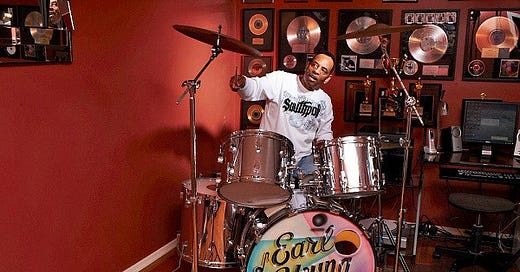



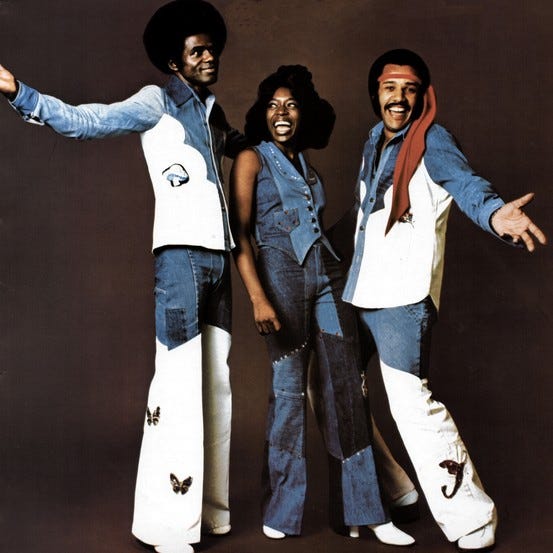
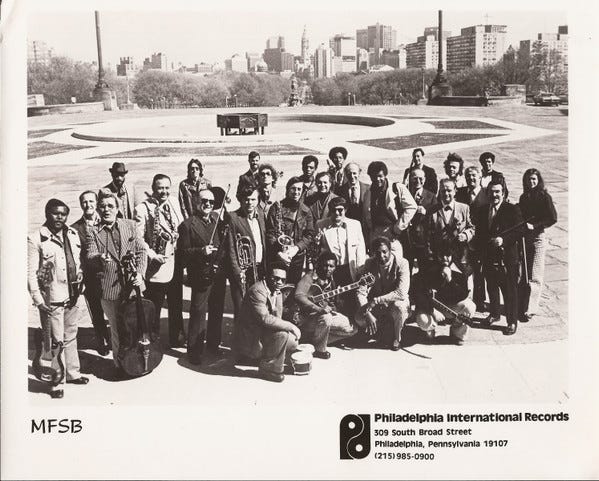
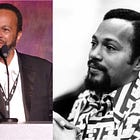

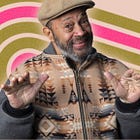
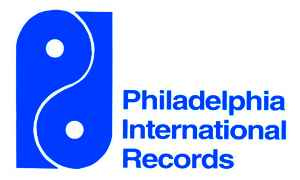
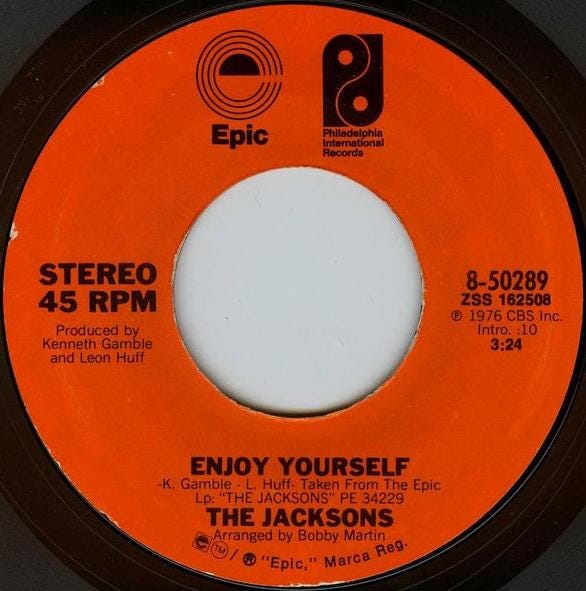
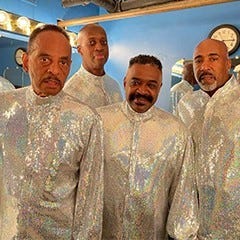

Awesome! It wasn't cool to like Disco back in the day. Until everybody started playing it.😀 Surprisingly bands that wouldn't be caught dead near a disco ball jumped on the band wagon eventually. Some strictly tongue in cheek. Some with no tongue. (Zappa, Kiss, Rod Stewart, Steppenwolf, ELO, Rush, Uriah Heep, Bad Company...and everyone else in the 70's and 80's). Thanks again, Brad, for the memories!
I have loved disco music since I first heard it
The Trammps were my favorite group & the trio of Baker, Harris, Young were the Best
Earl Young is an outstanding musician and everything he does is GOLD
I met the Trammps many years ago in a club in Long Island and saw them play at MSG at the Disco Dance party in the mid 70's
ABSOLUTELY OUTSTANDING